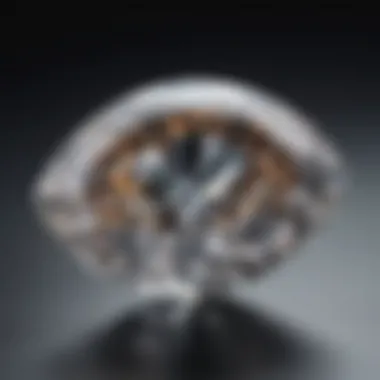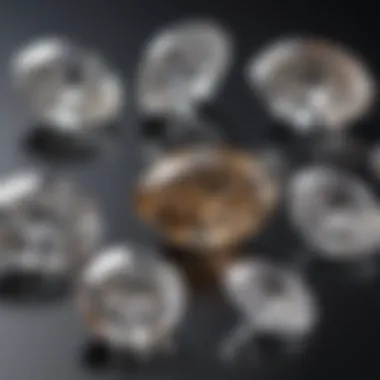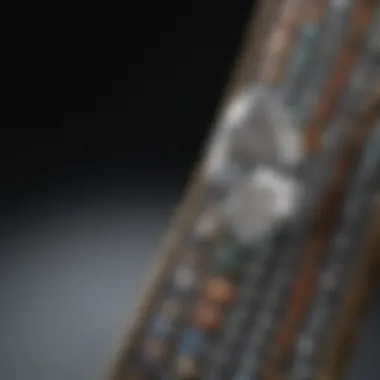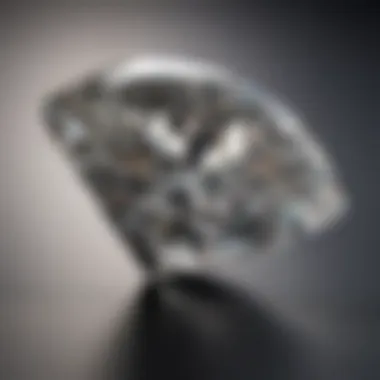Converting Marquise Diamonds: Millimeters to Carats


Intro
In the world of gemstones, understanding measurements is crucial for both enthusiasts and professionals. When it comes to marquise diamonds, one may find it challenging to convert the size measured in millimeters to the weight calculated in carats. This conversion is important for valuing the diamond accurately and ensuring it meets the expectations of buyers and sellers alike. The following sections will delve into the characteristics of the marquise cut, ways to calculate carat weight, and common misconceptions surrounding these diamonds.
Gemstone Overview
Definition and Characteristics
The marquise diamond is easily recognized by its distinctive shape that resembles a boat or an elongated oval. This unique shape allows for a larger surface area, giving it a brilliant appearance when cut properly. The marquise cut showcases the diamond's clarity and can enhance color by reflecting light in various angles. Its dimensions typically range in length and width, which are measured in millimeters to provide potential buyers with necessary specifications.
Classification of Gemstones
Gemstones are classified based on their mineral composition and the conditions under which they form. Diamonds fall under a specific category as they are made of carbon atoms arranged in a crystal lattice structure. Among diamonds, the marquise cut is categorized by its unique shape compared to classic cuts like the round or princess. Precise classifications help in understanding the specific values and qualities associated with gemstones.
Historical Significance
Ancient Uses and Cultural Importance
Throughout history, gemstones have held significant value in various cultures. Diamonds, including marquise shapes, were prized not only for their beauty but also for their perceived powers. They were often associated with wealth and status. The marquise cut itself was created in the 18th century and was inspired by the beauty of a French noblewoman, making it a symbol of elegance and royal presence.
Myths and Legends Surrounding Gemstones
There are numerous myths related to diamonds, including the marquise cut. Some believe that diamonds possess protective qualities and can bring good luck. Others associate them with love and commitment, often choosing diamond engagement rings for this reason. Such mythological beliefs reflect the rich tapestry of human culture surrounding gemstones and their lasting influences on society.
"Understanding the nuances of gemstone measurements not only aids in the market but enriches personal appreciation for these natural wonders."
This exploration of marquise diamonds not only sheds light on conversion methods but also on their inherent value, ensuring that both jewelers and buyers appreciate their significance in the jewelry market.
Intro to Marquise Diamonds
Marquise diamonds hold a unique position in the world of gemstones. Their elongated shape and brilliant facets can captivate the eye, making them a popular choice among those seeking distinctive elegance in jewelry. Understanding marquise diamonds extends beyond aesthetic appreciation; it delves into crucial aspects such as measurement, weight conversion, and the impact on value. In this article, we will explore why these factors are important for both buyers and sellers in the gemstone industry.
The conversion from millimeters to carats can be particularly challenging for those unfamiliar with diamond specifications. The marquise cut, known for its subtle curve and pointed ends, presents specific measurement considerations. Proper understanding of these nuances is vital not only for accurate valuation but also for ensuring buyer satisfaction. When prospective buyers know how to relate size and weight, they can make informed decisions.
As we navigate through this subject, we will unpack the history, characteristics, and the technical details that define marquise diamonds. This foundation will enhance your expertise, ensuring you can distinguish valuable insights from common misconceptions. From understanding the significant relationship between size and weight to recognizing how unique features affect overall measurement, this guide serves to elevate the knowledge base of gemstone enthusiasts, collectors, jewelry designers, and geology enthusiasts alike.
"The beauty of a marquise diamond lies not just in its shape but in the precision of its measurements. Understanding how to calculate weight from size is essential for any serious diamond buyer."
In the sections that follow, we will delve deeper into these topics and highlight the practical implications for your engagement with marquise diamonds. Knowing their history and characteristics will pave the way for an enriched understanding of measurement conversion.


Understanding Diamond Weight
Understanding diamond weight is crucial when discussing marquise diamonds, particularly in their conversion from millimeters to carats. The weight of diamonds is measured in carats, which directly influences their value in the jewelry market. Carat weight is often a primary consideration for buyers, as it typically correlates with size. However, it is essential to grasp that carat weight does not provide a complete picture of a diamond's appearance.
When evaluating diamonds, buyers must consider not just carat weight, but also how that weight expresses through the diamond's dimensions, shape, and cut quality. A well-cut marquise diamond might appear larger than a poorly cut diamond of equal carat weight. This discrepancy highlights the importance of considering both weight and how the diamond’s proportions affect its perceived size.
The Concept of Carats
Carats serve as the standard unit of weight for gemstones, including diamonds. One carat is equivalent to 200 milligrams, which is a small and precise measurement. The term "carat" originates from the carob seeds once used for weighing precious stones. Today, diamonds are meticulously weighed on scales designed for this purpose, ensuring that size and weight measurements remain consistent.
In the realm of diamonds, each carat is further divided into points, with one carat being equal to 100 points. This system allows for more granularity in describing weight, especially when distinguishing between smaller diamonds. For instance, a 50-point diamond weighs 0.50 carats. Understanding this system is fundamental for those purchasing marquise diamonds, as both carat weight and price usually increase as the diamond sizes increase.
How Weight Affects Value
Weight has a direct impact on the valuation of diamonds in several ways. Generally, as carat weight increases, the price per carat also rises. This phenomenon occurs because larger diamonds are rarer and, thus, more desirable in the market. Buyers should be mindful that weight is not the only factor influencing value. Other aspects like cut, color, and clarity also play a significant role in determining a diamond's overall worth.
On the other hand, the increase in price can often be exponential, rather than linear. For example, a one-carat diamond may not cost just twice as much as a half-carat one; the former may command a higher price because of its size, rarity, and the demand in the market. Therefore, understanding how weight correlates with value is essential for buyers making informed decisions about their investments in marquise diamonds.
"A diamond's value is not only determined by its weight but also how well it combines cut, clarity, and color."
By comprehending the significance of diamond weight, including the concept of carats and how it influences value, both buyers and jewelers can navigate the complexities of the market more effectively. This knowledge is particularly important when assessing marquise diamonds, where proportionality in size and carat can significantly alter perceptions and evaluations.
Conversion Basics: Millimeters to Carats
In the gemology world, the conversion from millimeters to carats is a fundamental aspect to understand when dealing with marquise diamonds. Knowing how to accurately convert these measurements is crucial for various stakeholders including buyers, sellers, and jewelers. This ensures one receives the best value for their investment. Incorrect estimations can lead to dissatisfaction, loss of trust, and potential monetary loss.
The Relationship Between Size and Weight
The relationship between size and weight is pivotal in understanding how a marquise diamond is perceived. Size, measured in millimeters, directly influences the diamond's weight in carats. The marquise cut, with its elongated shape and pointed ends, gives the appearance of greater size compared to other shapes. However, not all diamonds of the same size weigh the same, due to variations in their cut and proportions.
Interestingly, two marquise diamonds can share the same millimeter measurements yet differ significantly in weight. This can confuse buyers and lead to misconceptions about the diamond's true value. Jewelers often emphasize these nuances, highlighting that precision in measurements is paramount.
A general rule for marquise diamonds is that approximately 1 carat corresponds to about 6.5 – 7.5 millimeters in length and 4 – 5 millimeters in width. However, the specific ratio can change based on individual diamond characteristics. Attentiveness to these factors ensures buyers make informed decisions.
Tools and Formulas for Conversion
Accurate conversion tools and formulas are essential for jewelers and buyers alike. One of the most straightforward methods involves basic calculations, but various tools also streamline the process. Understanding these resources enhances one’s ability to make well-informed choices.
For practical conversions, the following formulas are often employed:
- Weight in Carats = (Length x Width x Depth) x 0.0061
This formula provides a rough estimate based on the diamond's dimensions. While this method yields approximate results, for precise evaluations, professionals may rely on specialized software designed specifically for gemstone measurements.


Additionally, many jewelers utilize digital scales and measurement calipers to determine both size and weight accurately. Investing in these tools can significantly increase the reliability of the conversions made.
In essence, converting between millimeters and carats requires a good grasp of the mathematical relationships involved, complemented by the right tools. Access to accurate data ensures transparency in transactions and can help eliminate confusion in the minds of buyers.
Specifics of Marquise Diamond Measurements
When discussing marquise diamonds, understanding the specifics of their measurements is essential. This section sheds light on the importance of accurately assessing these metrics. Clarity in size and weight conversion helps both buyers and jewelers make informed decisions. It affects factors like price, design choices, and overall aesthetic appeal.
The marquise cut, with its distinct elongated shape, presents unique challenges and considerations in measurement. Variations in dimensions can have a significant impact on the visual presentation of the diamond. Hence, familiarizing oneself with this knowledge aids in making educated choices during purchase or design.
Standard Measurements for Marquise Diamonds
Marquise diamonds typically possess specific proportions that can influence their perceived size. Unlike more common shapes such as round or princess cuts, marquise diamonds have standard measurements that are defined by length and width ratios. The average ratio aimed for is approximately 2:1, meaning that the length should ideally be double the width. However, slight deviations from this ideal can still result in an attractive stone.
Common Sizes and Measurements:
- Length: Common ranges include 18mm to 26mm.
- Width: Commonly spans from 9mm to 13mm.
- Depth: Often measured at around 4mm to 6mm.
Additionally, a focus on carat weight must not overshadow the importance of dimensions. It is vital to note that two marquise diamonds with the same carat weight can exhibit varying appearances based on their specific measurements. Understanding these details can help diamond enthusiasts appreciate how size dimensions correlate with the overall visual impact of the stone.
Unique Features Affecting Size
Several factors contribute to how size influences the measurement of marquise diamonds. The unique cut style enhances its length, thus impacting the visual weight and perceived size. The bow-tie effect often seen in marquise shapes can also affect the appreciation of the stone's size. Factors like this must be contemplated when evaluating a diamond's weight in millimeters versus carats.
Furthermore, the angles and overall symmetry play a vital role in the stone’s physical appearance. Variations in these features, even if minor, can lead to significant differences in how the diamond looks to the naked eye. This element affects the decision-making during purchasing and setting the diamond into jewelry.
For those interested in jewelry design, a profound understanding of these unique traits adds layers to selecting the right marquise diamond. It ensures that the end product meets aesthetic expectations, while also committing to optimal quality. Buyers should keep these elements in mind as they consider their purchasing choices.
"Understanding the intricacies of marquise diamond measurements is key to appreciating their beauty and value."
The interplay of weight, dimensions, and angles not only defines the unique identity of the marquise diamond but also underscores the importance of accurate measurement conversions in the broader context of gemology.
Common Misconceptions in Diamonds
Misconceptions surrounding marquise diamonds can mislead buyers and enthusiasts. Clarifying these misunderstandings is crucial for informed decision-making and for appreciating the true value of these stones. Understanding the realities behind marquise diamonds not only aids buyers but also empowers jewelry designers, dealers, and collectors. This section tackles two important areas often confused in the diamond realm.
Size vs. Actual Weight
One of the most common misconceptions is equating the size of a diamond with its actual weight measured in carats. A marquise diamond, with its elongated shape, can appear larger than its weight suggests. This optical illusion often leads individuals to misjudge its true value.


- Perception of Size: Marquise diamonds may look larger due to their cut, which maximizes surface area. This can create the impression that a smaller carat weight is actually more substantial than other shapes, like round diamonds.
- Carat Weight Explained: Carat weight refers to the actual weight of the diamond, not its size appearance. For example, a one-carat marquise may visually resemble a one-carat round diamond, but can have a different size profile based on the cut proportion.
Understanding the difference between size and weight is significant for anyone considering marquise diamonds. This knowledge avoids a potential mismatch between expectations and reality, ensuring a well-informed buying experience.
Oval vs. Marquise: A Comparison
Another prevalent misconception is the confusing similarity between the marquise and oval cuts. While they may appear similar at first glance, they possess distinct characteristics.
- Shape and Design: The marquise cut has pointed ends, resembling a boat or a leaf, while the oval cut is rounded at both ends. This design difference results in unique light reflection properties, affecting sparkle and brilliance.
- Weight Distribution: The marquise cut typically has a longer length-to-width ratio, which may result in weight appearing different than an oval cut of similar carat weight. Therefore, they may not always be interchangeable in terms of appearance and value.
Practical Tips for Buyers
Understanding how to navigate the nuances of buying a marquise diamond is essential, especially when converting millimeters to carats. The buying process can be overwhelming, yet having practical tips can significantly enhance your experience and outcomes. These insights can lead to better decisions, ensuring you find a diamond that aligns with your preferences and budget.
Understanding Certification
Certification plays a crucial role in the diamond purchasing process. Buyers should always look for certifications from reputable gemological laboratories. The most recognized labs include the Gemological Institute of America (GIA) and the International Gemological Institute (IGI). These organizations provide detailed reports on the diamond's quality, including its cut, clarity, color, and carat weight.
When evaluating certification, consider these aspects:
- Authenticity: Make sure the certification is genuine, as fake third-party certifications can mislead buyers.
- Detailed Reports: Look for a certification that provides in-depth analysis. This includes a plotted diagram showing inclusions and notable features of the stone.
- Reputation of the Lab: Some certification bodies are more recognized than others. The GIA is often seen as the gold standard in the industry, lending credibility to the diamond's valuation.
Choosing the Right Size for Your Needs
Selecting the ideal size for your marquise diamond goes beyond just the carat weight. Buyers should consider how the diamond's dimensions align with their preferences and occasion. Factors such as hand size, setting style, and personal taste all play an important role in making a suitable choice.
Some tips for choosing the right size include:
- Consider Your Finger Size: Marquise diamonds can appear larger or smaller depending on the cut. A well-proportioned marquise often looks larger due to its elongated shape. Testing out rings of similar styles can provide a good reference.
- Setting Matters: The ring's setting can affect how the diamond appears. A minimalist setting may make a smaller diamond look more substantial, while a complex one might overshadow it.
- Personal Preference: Ultimately, the right size is subjective. Prioritize what appeals to you. Whether it is grandeur you seek or something modest and elegant, aligning your choice with your taste is essential for long-term satisfaction.
Aim for a balance between your personal style and what fits within your budget. Quality should never be sacrificed for size.
Selecting the right diamond requires careful consideration of various factors. Integrating these practical tips will empower buyers, allowing them to make informed decisions in the often complex jewelry market. By understanding certification and recognizing the significance of size relative to personal needs, buyers can confidently select a marquise diamond that captures both beauty and value.
Epilogue
Accurate conversion from millimeters to carats is crucial for anyone dealing with marquise diamonds. Mastering this process enables gemstone enthusiasts, collectors, and jewelry designers to make informed decisions, enhancing their appreciation for these elegant gemstones.
Summing Up the Importance of Accurate Conversion
The significance of precise conversion cannot be overstated. Understanding the weight of a marquise diamond relative to its size directly affects both valuation and selection. Carat weight serves as a primary metric in determining the cost of a diamond. A clearer sense of this relationship allows for better negotiations in purchasing.
Moreover, consumers should appreciate that a larger size does not always equate to higher quality. The cut and overall aesthetics of a marquise diamond play notable roles as well. By mastering the conversion from millimeters to carats, buyers gain deeper insight into features that enhance the diamond's allure, enhancing choices based on data rather than myths or assumptions.
Importantly, accurate conversion affects not only individual transactions but also broader market trends within the jewelry industry. As the community grows more educated, a ripple effect can influence pricing strategies and quality assessments. Jewelers who provide clarity on measurements boost trust and enhance their reputation among clients.
In summary, understanding the accuracies in measuring marquise diamonds positions all parties—buyers, sellers, and designers—toward more rewarding encounters in the gemstone market. With a blend of knowledge and precise calculation methods, the fascination with marquise diamonds can transition seamlessly into practical application.







